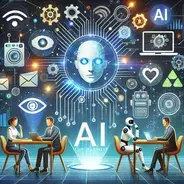How to Integrate AI in Business: Step-by-Step Guide for Success

In today's rapidly evolving business landscape, integrating Artificial Intelligence (AI) is no longer a futuristic concept but a strategic imperative for staying competitive and driving growth. This guide provides a practical, step-by-step approach to seamlessly incorporating AI into your operations, not as a daunting technological overhaul, but as a natural extension of your business evolution. We'll explore how to identify the most promising opportunities within your specific industry, address common challenges proactively, and ultimately harness the transformative power of AI to unlock new levels of efficiency, innovation, and customer satisfaction.
Think of it not as replacing the human element, but as empowering your team with intelligent tools that amplify their capabilities and free them to focus on higher-value tasks. By carefully implementing this guide, you'll be well on your way to realizing the full potential of AI and charting a course for sustainable success in the years to come. The key to this transition is not just about adopting the technology, but about strategically and thoughtfully weaving it into the fabric of your business, creating a harmonious synergy between human ingenuity and artificial intelligence. This journey is about augmenting, not replacing, the human touch, leveraging AI to empower your team, enhance your operations, and create more meaningful customer interactions.
Why Integrate AI into Your Business?
Integrating AI into your business isn't just about keeping up with the latest trends; it's about unlocking a wealth of tangible benefits that can revolutionize your operations and propel you ahead of the competition. By automating repetitive tasks, AI frees up your human workforce to focus on more strategic, creative, and fulfilling endeavors, leading to increased productivity and employee satisfaction. Imagine your customer service team empowered by AI-powered chatbots that handle routine inquiries, allowing them to focus on resolving complex issues and building stronger customer relationships.
Beyond efficiency gains, AI provides unparalleled insights into your data, revealing hidden patterns and trends that would be impossible to discern through traditional methods. This data-driven decision-making allows for more accurate forecasting, personalized marketing campaigns, and optimized resource allocation, leading to improved profitability and a stronger bottom line.
Moreover, AI can foster innovation by enabling the development of new products and services, enhancing customer experiences through personalized recommendations, and even streamlining supply chains for greater efficiency. This is not about replacing the human element, but about enhancing it, equipping your team with intelligent tools that amplify their skills and enable them to achieve more than ever before. It allows for a shift from reactive to proactive problem solving. Essentially, embracing AI is an investment in the future of your business, positioning you to thrive in an increasingly dynamic and competitive environment. It's about creating a smarter, more agile, and ultimately more successful organization.
Identifying AI Opportunities in Your Industry
The first step towards successful AI integration is identifying the specific areas within your industry and your organization where AI can deliver the most significant impact. This requires a thorough understanding of your core business processes, pain points, and strategic objectives. Start by analyzing your existing workflows and identifying tasks that are repetitive, time-consuming, or prone to human error. These are prime candidates for automation through AI-powered solutions. For example, in the retail industry, AI can be used to optimize inventory management, personalize product recommendations, and detect fraudulent transactions.
In healthcare, AI can assist with diagnosis, drug discovery, and personalized treatment plans. Manufacturing companies can leverage AI for predictive maintenance of machinery, quality control, and optimizing production schedules. Look for opportunities to enhance customer experience through AI-powered chatbots, personalized recommendations, or sentiment analysis of customer feedback. The key is to focus on areas where AI can provide a clear return on investment, whether it's through cost savings, increased efficiency, improved customer satisfaction, or new revenue streams.
Don't try to force AI into every aspect of your business; instead, be strategic and prioritize the opportunities that align with your overall goals and have the greatest potential for positive impact. Consider consulting with AI experts or industry specialists to gain a deeper understanding of the possibilities and to tailor solutions to your specific needs. Remember, successful AI integration is a journey, not a destination, and it starts with identifying the right opportunities to embark on that journey.